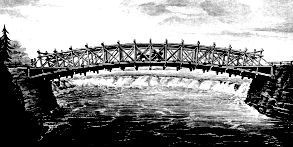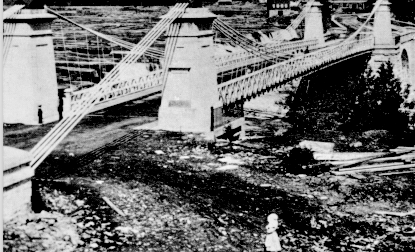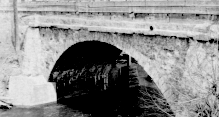
The Union Bridge and its successors

In 1828 a series of stone and wooden bridges across the Chaudière Falls were built under the direction of Lt. Colonel John By. The new bridges would make it easier to bring supplies in from Montreal to support the construction of the Rideau Canal which was just starting. A wooden arch bridge was built ever the main channel of the river while over shorter streams between some rocky islands were built a few stone bridges. The wooden arch bridge lasted until 1835 when damage from March ice flows brought it down.

The wooden arch bridge was replaced in 1843 with a suspension bridge which looked a bit like a rustic version of the Brooklyn or San Francisco bridge. The new bridge had stone tower piers holding the suspension cables and a wagonway stiffened by wooden trusses. The suspension bridge was only 20 feet wide and soon inadequate for the traffic it needed to carry. The engineer for this bridge was Samuel Keefer and in its day it was a major civil engineering achievement for Canada.

This bridge was then replaced in 1889 by the "Old Union Bridge", a steel truss bridge built by Messis, Rousseau and Mather. By 1914 the Old Union bridge was considered too weak for the loads it had to carry and in 1919 a contract was awarded to the Dominion Bridge company of Lachine Quebec to build the current bridge and abutments.
A W.H.Bartlett print published in 1940 showed the first wooden truss Union bridge, and a second wooden truss bridge between Victoria Island and Amelia Island on the Ontario side along with four stone arches on the Québec side. Parts of these 1828-43 stone arches still remain as hidden supporting structures to the modern bridges here. These are among the most important monuments of the pioneer era in Ottawa.
How can you see this old stone bridge? Walk up to the traffic lights at the truck entrance just north of the current steel truss bridge. Wait for the lights to change and then go to the raised walled open area that divides the traffic flow. The 1928 stone arch may be seen inside there. This arch is also visible to bus passengers driving from Lebreton Flats to Hull in the morning. It seems to be in fair repair considering...

Now shoot across to the other side of the road into the driveway into the Hydro Québec Generator #2 building a little to the south and west. (Make sure you are at where the Hydro Québec #2 sign is, and not at the entrance to the Eddy plant.) Here is a different view of the same arch, plus looking south, a view of a different stone arch being the foundation of the current Union (Chaudière) steel truss bridge. A different view may be had from the north-north-west corner of the board mill - building 1.
John MacTaggart, Clerk of Works for the canal project, writes in a letter dated October 18, 1826.
Behold but the scene, look at the mass of waters coming smoking over the shelving precipices, formed of the hardest horizontal strata of laminated limestone: - down they tumble, in some places more than one hundred feet, into the cauldrons or kettles beneath; where, instead of their furiously driving, as you may imagine, down the channel, they in some instances vanish fairly, work their way through subterranean passages, and come up boiling white half a mile down the river.
It has been told by one of my countrymen here, that a cow one morning tumbled into the Little Kettle or Chaudière, and coming up again at fox point, ten miles down the river; and on my enquiring if she came up alive, he explained, with all the water kelpie enthusiasm of his old Scotland, "That she did sae; she came up rowting, and she lived fat and fu' for years after."
But, to lay joking aside, this bridge, if we manage to build and finish it off as we ought, will surpass almost any other in the world as a wonderful piece of superstructure. It is to have eight arches; five of 60 feet span, two of 70 feet, and one of 200 feet over the Big Kettle, where sounding-line hath not yet found a bottom at 300 feet deep. One of these bridges of 60 feet span, we are just finishing, and putting up centering for one of the 70 feet arches.
Material are just for the lifting, of the best quality. Nature was never so kind. Plenty of timber, plenty of stone, good abutments - the truth is we build no abutments, but spring with the arches directly from the rocks themselves. The road-way will be about 30 feet wide; and as the spring floods of the Ottawa rise 24 feet, we are obliged to raise the arches high to keep out of harms's way.
